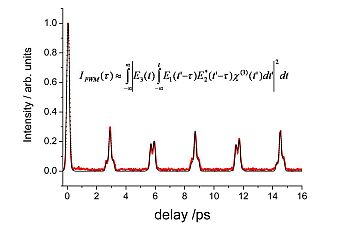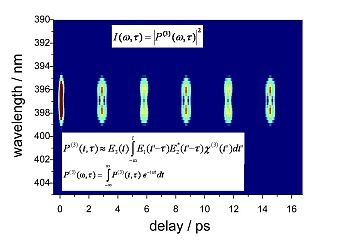Dispersed fs Four Wave Mixing
When the fs-FWM signal is time gated or equivalently spectrally dispersed, a second dimension is uncovered that may provide
additional information on the coherent contributions that form the output.
In strictly time domain measurements, the rotational manifold leads to rapid dephasing of
nuclear correlations. Although this is a coherent evolution and the signal will rephase, the dense rotational manifold acts
as a bath that limits the information and wave packet control in 1D spectroscopy.
In strictly non-resonant FWM (coherent spike), the susceptibility c is a mixing constant without time development and
all three pulses must coincide for there to be a signal. The spectral window can be defined as convolution of the three
fields determined by the matching condition of the carrier frequencies. Under resonant conditions, c
contains the time dependent material response. Now the pulses need not to coincide and the polarization may evolve past the duration of its preparation.
The persistence of the polarization necessarily implies spectral modification and the signal beam contains a spectrum.
 |
 |
Figures: Time integrated (experiment and simulation) and dispersed TG signal (simulation) of O2.
The dispersed TG method may be used as ´in situ´ pulse characterization of the probe pulse during the measurement
as it resembles a FROG (frequency resolved optical gating) analysis of the probe laser pulse.
This is of high interest, especially when pulses in the UV spectral range are used in the experiments.
Figures: Left: Measured Phase of the Laser pulse used in the experiment by FROG technique (Grenouille Swamp Optics). Right: Pulse used for
simulation of the dispersed TG signal of O2.
Back
.
